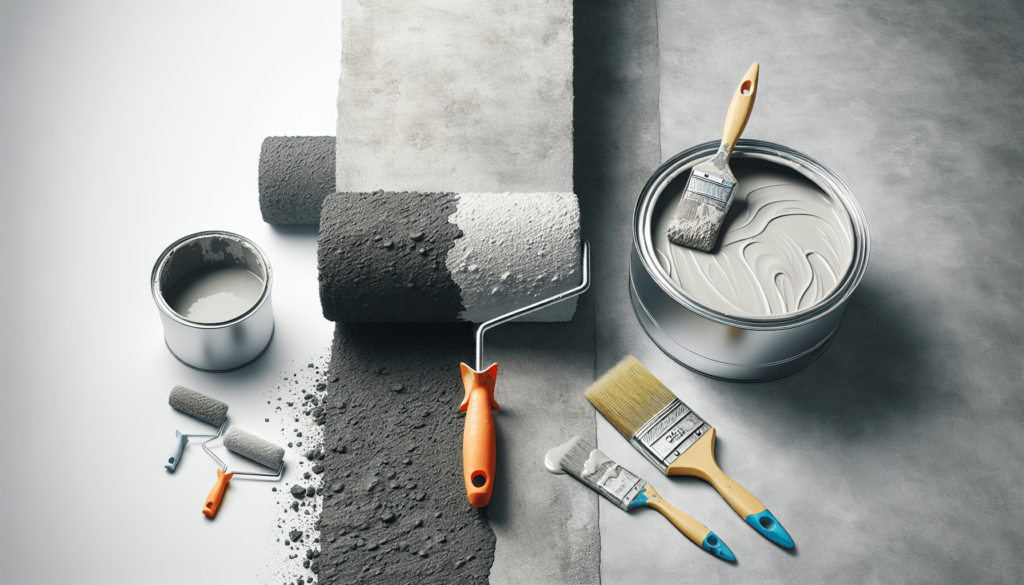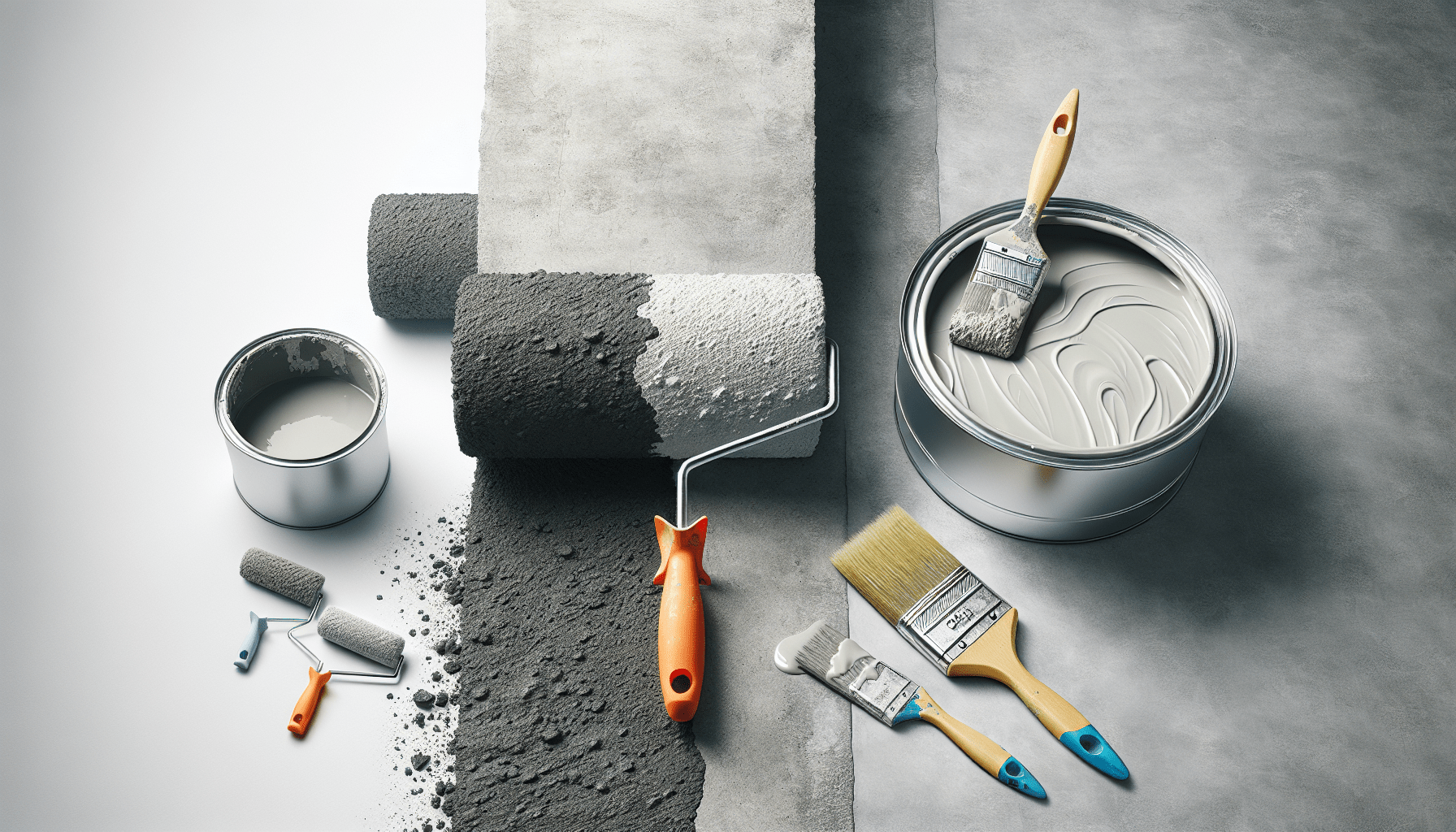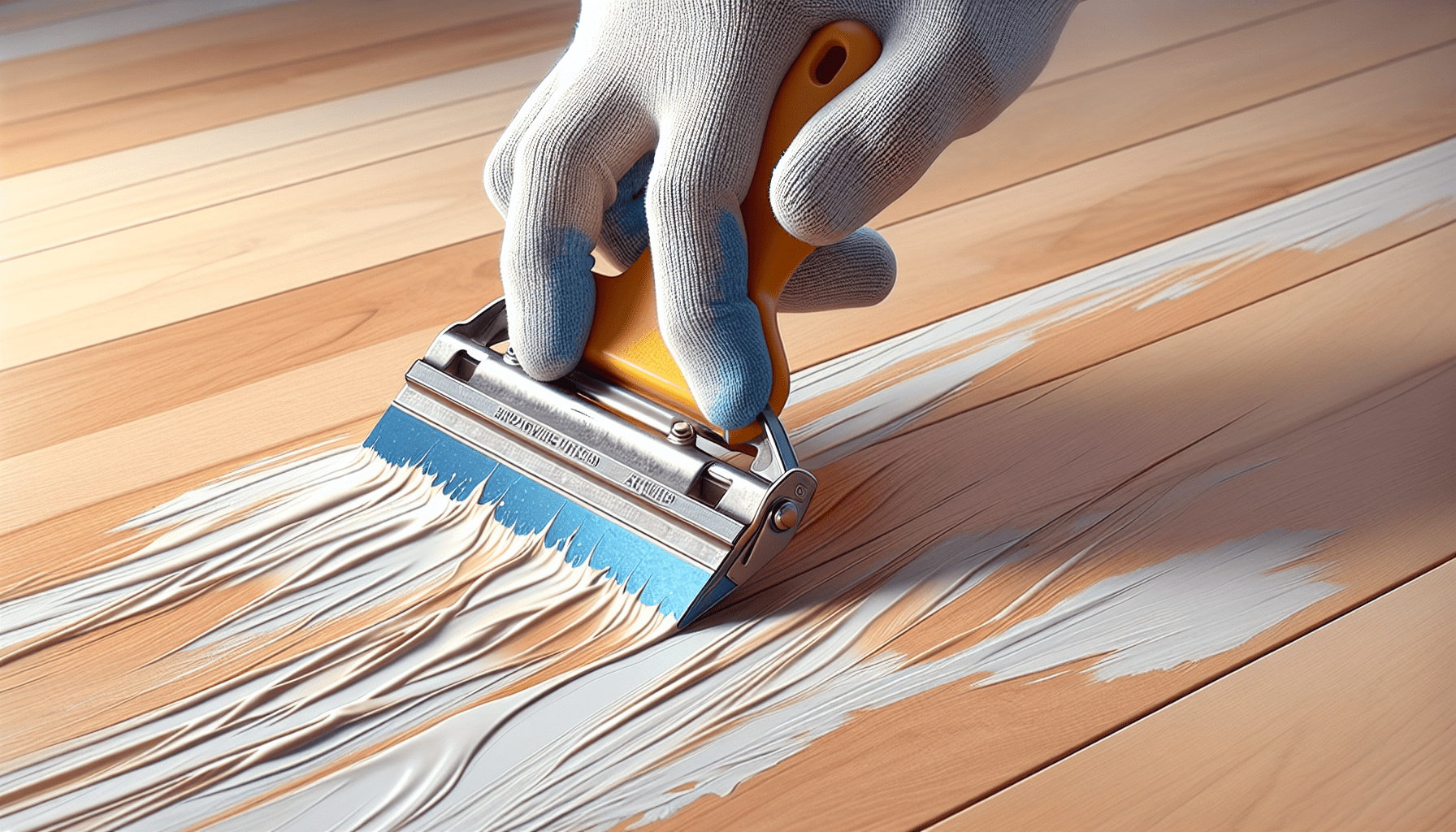Latex paint has long been a popular choice for interior and exterior painting projects. However, when it comes to concrete surfaces, the question arises: Can you use latex paint on concrete? In this article, we will explore the compatibility of latex paint with concrete surfaces and provide you with valuable insights on the best practices and considerations to bear in mind when tackling such a project. Whether you are a DIY enthusiast or a professional contractor, understanding the possibilities and limitations of using latex paint on concrete will help you achieve a flawless and long-lasting finish that meets your expectations.
What is Latex Paint
Latex paint is a popular choice for many homeowners and professionals when it comes to painting various surfaces, including concrete. It is a water-based paint that contains synthetic polymers, which give it its unique properties and advantages. Understanding the composition of latex paint, as well as its advantages and suitability for concrete surfaces, is essential for successfully using it in your painting projects.
Composition of Latex Paint
Latex paint is composed of several key ingredients that work together to create a durable and long-lasting finish. The main component of latex paint is water, which serves as the solvent for the other ingredients. It also contains various types of polymers, such as acrylic, vinyl, or a combination of both. These polymers provide the paint with flexibility and adhesion, allowing it to adhere to a variety of surfaces, including concrete. Additional additives, such as pigments for color, extenders for improved coverage, and surfactants for surface tension reduction, are also included in the formulation of latex paint.
Advantages of Latex Paint
Using latex paint on concrete surfaces offers several advantages that make it a popular choice among homeowners and professionals alike. One of the key advantages of latex paint is its ease of use. Latex paint dries quickly, which means you can apply multiple coats in a relatively short amount of time. It is also easy to clean up with soap and water, making it convenient and efficient for both application and maintenance.
Another advantage of latex paint is its durability. Latex paint forms a tough and flexible film on the surface, allowing it to withstand daily wear and tear. It is resistant to cracking, peeling, and chipping, making it suitable for high-traffic areas or areas exposed to harsh weather conditions. Additionally, latex paint is formulated to be resistant to mold and mildew growth, making it an excellent choice for areas with high humidity or moisture.
Latex paint is available in a wide range of colors, allowing you to achieve the desired aesthetics for your concrete surfaces. It comes in various sheen levels, from flat to high gloss, giving you the flexibility to choose the level of shine you prefer. Whether you want a subtle matte finish or a vibrant glossy look, latex paint can deliver the desired results.
Suitability for Concrete Surfaces
One of the common questions homeowners have is whether latex paint can be used on concrete surfaces. The answer is yes, latex paint is suitable for painting concrete, given proper preparation and application techniques. Concrete is a porous material, and latex paint can adhere well to its surface when the concrete is clean, dry, and free of any contaminants or impurities.
Preparation
Before painting concrete surfaces with latex paint, proper preparation is crucial to ensure a successful and long-lasting finish. There are several steps involved in preparing the concrete surface, including cleaning the surface, repairing any damage, and applying a primer.
Clean the Surface
Cleaning the concrete surface thoroughly is essential to remove any dirt, dust, grease, or other contaminants that may hinder the paint’s adhesion. Start by sweeping or vacuuming the surface to remove loose debris. Then, use a pressure washer or a scrub brush with a mixture of mild detergent and water to clean the surface thoroughly. Rinse off the cleaning solution and allow the surface to dry completely before proceeding to the next step.
Repair Any Damage
Inspect the concrete surface for any cracks, chips, or other damage that needs to be repaired. Use a concrete patching compound to fill in any cracks or holes, following the manufacturer’s instructions. Allow the patching compound to dry and cure completely before proceeding.
Apply a Primer
Applying a primer is essential when painting concrete surfaces with latex paint. Primer helps the paint adhere better to the concrete, improves coverage, and enhances the overall durability of the paint job. Choose a primer specifically formulated for concrete surfaces and apply it according to the manufacturer’s instructions. Allow the primer to dry completely before applying the paint.
Choosing the Right Latex Paint
When it comes to choosing the right latex paint for your concrete surfaces, there are a few factors to consider. Checking for concrete-specific formulations, considering the sheen level, selecting the appropriate color, and ensuring the quality of the paint are all important considerations.
Check for Concrete-Specific Formulations
Not all latex paints are suitable for concrete surfaces. Look for latex paint formulations that are specifically designed for use on concrete. These formulations are engineered to adhere well to the porous surface of concrete, providing better durability and longevity. They often contain additives that enhance the paint’s performance on concrete surfaces.
Consider the Sheen Level
The sheen level refers to the level of glossiness or shine in the paint’s finish. Consider the look you want to achieve and the functional requirements of the concrete surface when choosing the sheen level. Flat or matte finishes are ideal for hiding imperfections, while high gloss finishes offer a sleek and reflective surface. Semi-gloss or satin finishes are often a good compromise, providing some sheen while still maintaining a smooth appearance.
Selecting the Appropriate Color
The color of the latex paint is an important consideration when painting concrete surfaces. Choose a color that complements the surrounding environment or fits your desired aesthetics. Keep in mind that lighter colors may require more frequent maintenance to keep them looking clean, while darker colors can help hide stains and imperfections.
Quality of the Paint
Investing in high-quality latex paint is essential for achieving a long-lasting and professional-looking finish. Look for reputable brands that offer paint specifically formulated for concrete surfaces. Quality paints often contain a higher percentage of solids, ensuring better coverage and adhesion. Additionally, they tend to have better color retention, resistance to fading, and overall durability.
Application Techniques
When it comes to applying latex paint on concrete, there are several techniques you can use, including brushing, rolling, and spraying. The technique you choose will depend on the size and complexity of the concrete surface, as well as your personal preference.

Brushing
Brushing is a common and traditional method of applying latex paint on concrete surfaces. It is especially useful for smaller areas or when precision is required, such as when painting edges or corners. Use a high-quality nylon or synthetic bristle brush and apply the paint in even strokes, working in sections to ensure a consistent finish. Make sure to blend each brush stroke with the previous one to avoid visible brush marks.
Rolling
Rolling is a popular technique for larger concrete surfaces, as it allows for faster application and better coverage. Use a high-quality roller sleeve specifically designed for smooth or semi-smooth surfaces. Roll the paint onto the concrete surface in a “W” or “M” pattern, overlapping each stroke to ensure even distribution of the paint. Backroll the paint with light pressure to smooth out any air bubbles or roller marks.
Spraying
Spraying is a technique commonly used for large or uneven concrete surfaces. It allows for quick and efficient application of the paint, ensuring a smooth and uniform finish. Use an airless sprayer or a compressed air sprayer, following the manufacturer’s instructions. Properly prepare the sprayer and adjust the spray pattern and pressure to achieve the desired coverage. Take caution to protect surrounding areas from overspray and wear appropriate protective equipment, such as goggles and a respirator.
Steps to Apply Latex Paint on Concrete
Once the surface is properly prepared and you have chosen the right latex paint, follow these steps to achieve a successful paint job on concrete surfaces.
Prime the Surface
Before applying the paint, apply a coat of primer specifically formulated for concrete surfaces. Use a brush, roller, or sprayer to apply the primer evenly, following the manufacturer’s instructions. Allow the primer to dry completely before proceeding to the next step.
Apply the First Coat
Once the primer is dry, apply the first coat of latex paint to the concrete surface. Use the technique that works best for your specific project, whether it’s brushing, rolling, or spraying. Apply the paint evenly and consistently, making sure to cover the entire surface. Keep a wet edge to avoid visible lap marks or uneven drying.
Allow Sufficient Drying Time
After applying the first coat of paint, allow sufficient drying time before applying additional coats. The drying time will depend on various factors such as temperature, humidity, and ventilation. Check the manufacturer’s instructions for specific recommendations, but typically, latex paint may require several hours to dry to the touch and 24 hours or more to fully cure.
Apply Additional Coats if Required
Once the first coat has dried, assess the coverage and decide if additional coats are necessary. If the paint appears thin or does not fully cover the concrete surface, apply additional coats following the same technique and allowing sufficient drying time between coats. Applying multiple thin coats instead of one thick coat will result in a more even and durable finish.
Finish with a Protective Sealer
To enhance the durability and longevity of the painted concrete surface, consider applying a protective sealer after the final coat of paint has dried and cured. A sealer creates a barrier that helps prevent moisture penetration, staining, and damage from UV rays. Choose a sealer specifically designed for use on latex-painted surfaces and apply it according to the manufacturer’s instructions.
Tips for Achieving Best Results
To ensure the best possible results when using latex paint on concrete surfaces, consider the following tips:
Temperature and Weather Considerations
The temperature and weather conditions can greatly affect the drying and curing time of latex paint. Avoid painting concrete surfaces in extremely hot or cold temperatures, as it may lead to poor adhesion and drying issues. Additionally, avoid painting during rainy or high humidity days, as excessive moisture can interfere with the paint’s performance. Aim for optimal temperature and humidity conditions as recommended by the paint manufacturer.
Proper Ventilation
Proper ventilation is crucial when painting with latex paint, as it helps facilitate drying and prevents the buildup of fumes. If possible, open windows and doors to create a cross breeze. Use fans or other ventilation devices to increase airflow in the painting area. It is also important to ensure proper respiratory protection by wearing a mask or respirator specifically designed for painting.

Use of Proper Tools
Using the appropriate tools for the job is essential for achieving a professional-looking finish. Invest in high-quality brushes, rollers, or sprayers specifically designed for latex paint and concrete surfaces. Poor quality or worn-out tools can result in an uneven application, visible brush or roller marks, or overspray. Follow the manufacturer’s recommendations for the type and size of applicators to use.
Apply Multiple Thin Coats
As mentioned earlier, applying multiple thin coats of latex paint is preferable to one thick coat. Thin coats allow for better adhesion and coverage, as well as a smoother and more durable finish. Follow the recommended drying time between coats to ensure proper curing and avoid reapplication too soon, which can lead to surface damage.
Follow Manufacturer’s Instructions
Always follow the manufacturer’s instructions when using latex paint on concrete surfaces. Each paint brand and product may have specific guidelines for proper preparation, application, and drying times. Following these instructions will ensure the best results and help maintain the paint’s durability over time.
Pitfalls to Avoid
To avoid potential issues and ensure a successful paint job on concrete surfaces, be mindful of the following pitfalls:
Not Cleaning the Surface Thoroughly
Skipping the thorough cleaning of the concrete surface can result in poor adhesion and paint failure. Take the time to remove all dirt, oil, grease, or other contaminants that may hinder the paint’s ability to adhere properly. Failing to do so can lead to premature peeling, flaking, or chipping of the paint.
Skipping Primer Application
Applying a primer before painting is crucial, especially on concrete surfaces. Primer enhances adhesion, improves coverage, and helps the paint bond to the porous surface of the concrete. Skipping this step can result in poor paint performance and premature failure.
Using the Wrong Type of Paint
Using latex paint that is not specifically formulated for concrete surfaces can lead to poor adhesion and durability. Make sure to choose a latex paint designed for use on concrete for the best results. Using interior wall paint or other general-purpose latex paints may not provide the same level of performance and longevity.
Applying Too Thick a Coat
Applying a thick coat of latex paint may seem like a time-saving approach, but it can actually result in poor adhesion and an uneven finish. Thick coats take longer to dry and cure, increasing the risk of surface imperfections, bubbling, or cracking. Stick to multiple thin coats for a more professional and durable finish.
Not Sealing the Painted Surface
To protect the paint and enhance its longevity, consider applying a protective sealer after the paint has dried and cured. Skipping this step can result in premature wear, staining, and damage to the painted surface. A sealer acts as a barrier, preventing moisture penetration and offering additional protection against UV rays and other environmental factors.
Maintenance and Longevity
Proper maintenance is important to keep latex-painted concrete surfaces looking their best and prolong their lifespan. Here are some tips for maintaining and maximizing the longevity of your painted concrete surfaces:
Regular Cleaning
Regularly clean the painted concrete surfaces to remove dirt, dust, and other debris that can accumulate over time. Use a mild detergent and water solution, along with a soft brush or mop, to gently clean the surface. Avoid using harsh or abrasive cleaners that can damage the paint.
Prevention of Water Damage
To prevent water damage, ensure that water is properly directed away from the painted concrete surfaces. Keep gutters and downspouts clear of debris and ensure they are functioning properly to prevent water from pooling or seeping into the concrete. Regularly inspect the painted concrete for any signs of water damage or leakage and address them promptly.
Reapplying the Paint as Needed
Over time, the painted concrete surfaces may require reapplication of latex paint to maintain their aesthetics and durability. Monitor the condition of the paint, looking for signs of fading, chipping, or peeling. When necessary, prepare the surface and apply additional coats of latex paint following the proper techniques and recommendations.
Monitoring and Repairing any Defects
Regularly inspect the painted concrete surfaces for any defects, such as cracks, chips, or other signs of damage. Promptly address these issues by repairing the concrete and applying touch-up paint as needed. Taking care of any defects early on can prevent further damage and ensure the longevity of the paint job.
Alternative Options
While latex paint is a popular choice for painting concrete surfaces, there are alternative options available that may better suit specific needs or preferences. Consider the following alternatives:
Concrete Stains
Concrete stains offer a different aesthetic approach to painting concrete surfaces. They penetrate the concrete, creating a natural, variegated appearance. Concrete stains come in a variety of colors and finishes, allowing you to achieve a unique and customized look for your concrete surfaces.
Epoxy Coatings
Epoxy coatings provide a highly durable and resistant finish for concrete surfaces. They create a thick protective layer that can withstand heavy use, chemicals, and abrasion. Epoxy coatings are often used in commercial or industrial settings but can also be applied in residential environments where maximum durability is desired.
Concrete Dyes
Concrete dyes offer a wide range of vibrant and translucent colors for concrete surfaces. They penetrate the concrete and produce intense, long-lasting colors. Concrete dyes can be combined to create custom hues and patterns, making them ideal for decorative or artistic applications.
Conclusion
In conclusion, latex paint can indeed be used on concrete surfaces, provided the proper preparation, choice of paint, and application techniques are followed. With its water-based formulation, durability, and flexibility, latex paint is a versatile option for painting concrete. Consider factors such as the surface condition, climate, and desired aesthetics when choosing latex paint for your concrete surfaces. Follow the recommended steps, tips, and guidelines outlined in this article to ensure the best results and maximize the longevity of your paint job.



